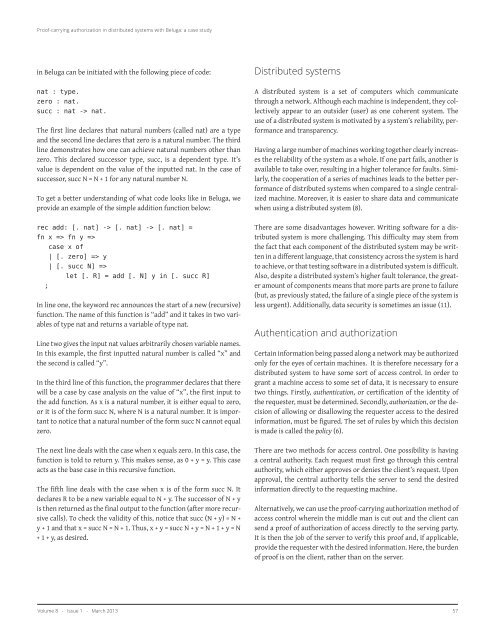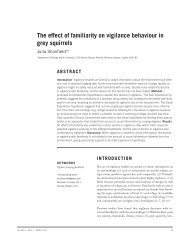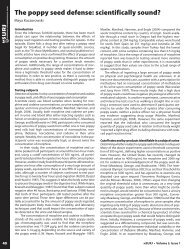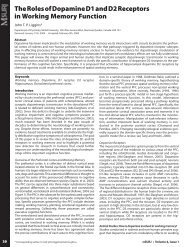the entire issue - McGill Science Undergraduate Research Journal ...
the entire issue - McGill Science Undergraduate Research Journal ...
the entire issue - McGill Science Undergraduate Research Journal ...
Create successful ePaper yourself
Turn your PDF publications into a flip-book with our unique Google optimized e-Paper software.
Proof-carrying authorization in distributed systems with Beluga: a case study<br />
in Beluga can be initiated with <strong>the</strong> following piece of code:<br />
nat : type.<br />
zero : nat.<br />
succ : nat -> nat.<br />
The first line declares that natural numbers (called nat) are a type<br />
and <strong>the</strong> second line declares that zero is a natural number. The third<br />
line demonstrates how one can achieve natural numbers o<strong>the</strong>r than<br />
zero. This declared successor type, succ, is a dependent type. It’s<br />
value is dependent on <strong>the</strong> value of <strong>the</strong> inputted nat. In <strong>the</strong> case of<br />
successor, succ N = N + 1 for any natural number N.<br />
To get a better understanding of what code looks like in Beluga, we<br />
provide an example of <strong>the</strong> simple addition function below:<br />
rec add: [. nat] -> [. nat] -> [. nat] =<br />
fn x => fn y =><br />
;<br />
case x of<br />
| [. zero] => y<br />
| [. succ N] =><br />
let [. R] = add [. N] y in [. succ R]<br />
In line one, <strong>the</strong> keyword rec announces <strong>the</strong> start of a new (recursive)<br />
function. The name of this function is “add” and it takes in two variables<br />
of type nat and returns a variable of type nat.<br />
Line two gives <strong>the</strong> input nat values arbitrarily chosen variable names.<br />
In this example, <strong>the</strong> first inputted natural number is called “x” and<br />
<strong>the</strong> second is called “y”.<br />
In <strong>the</strong> third line of this function, <strong>the</strong> programmer declares that <strong>the</strong>re<br />
will be a case by case analysis on <strong>the</strong> value of “x”, <strong>the</strong> first input to<br />
<strong>the</strong> add function. As x is a natural number, it is ei<strong>the</strong>r equal to zero,<br />
or it is of <strong>the</strong> form succ N, where N is a natural number. It is important<br />
to notice that a natural number of <strong>the</strong> form succ N cannot equal<br />
zero.<br />
The next line deals with <strong>the</strong> case when x equals zero. In this case, <strong>the</strong><br />
function is told to return y. This makes sense, as 0 + y = y. This case<br />
acts as <strong>the</strong> base case in this recursive function.<br />
The fifth line deals with <strong>the</strong> case when x is of <strong>the</strong> form succ N. It<br />
declares R to be a new variable equal to N + y. The successor of N + y<br />
is <strong>the</strong>n returned as <strong>the</strong> final output to <strong>the</strong> function (after more recursive<br />
calls). To check <strong>the</strong> validity of this, notice that succ (N + y) = N +<br />
y + 1 and that x = succ N = N + 1. Thus, x + y = succ N + y = N + 1 + y = N<br />
+ 1 + y, as desired.<br />
Distributed systems<br />
A distributed system is a set of computers which communicate<br />
through a network. Although each machine is independent, <strong>the</strong>y collectively<br />
appear to an outsider (user) as one coherent system. The<br />
use of a distributed system is motivated by a system’s reliability, performance<br />
and transparency.<br />
Having a large number of machines working toge<strong>the</strong>r clearly increases<br />
<strong>the</strong> reliability of <strong>the</strong> system as a whole. If one part fails, ano<strong>the</strong>r is<br />
available to take over, resulting in a higher tolerance for faults. Similarly,<br />
<strong>the</strong> cooperation of a series of machines leads to <strong>the</strong> better performance<br />
of distributed systems when compared to a single centralized<br />
machine. Moreover, it is easier to share data and communicate<br />
when using a distributed system (8).<br />
There are some disadvantages however. Writing software for a distributed<br />
system is more challenging. This difficulty may stem from<br />
<strong>the</strong> fact that each component of <strong>the</strong> distributed system may be written<br />
in a different language, that consistency across <strong>the</strong> system is hard<br />
to achieve, or that testing software in a distributed system is difficult.<br />
Also, despite a distributed system’s higher fault tolerance, <strong>the</strong> greater<br />
amount of components means that more parts are prone to failure<br />
(but, as previously stated, <strong>the</strong> failure of a single piece of <strong>the</strong> system is<br />
less urgent). Additionally, data security is sometimes an <strong>issue</strong> (11).<br />
Au<strong>the</strong>ntication and authorization<br />
Certain information being passed along a network may be authorized<br />
only for <strong>the</strong> eyes of certain machines. It is <strong>the</strong>refore necessary for a<br />
distributed system to have some sort of access control. In order to<br />
grant a machine access to some set of data, it is necessary to ensure<br />
two things. Firstly, au<strong>the</strong>ntication, or certification of <strong>the</strong> identity of<br />
<strong>the</strong> requester, must be determined. Secondly, authorization, or <strong>the</strong> decision<br />
of allowing or disallowing <strong>the</strong> requester access to <strong>the</strong> desired<br />
information, must be figured. The set of rules by which this decision<br />
is made is called <strong>the</strong> policy (6).<br />
There are two methods for access control. One possibility is having<br />
a central authority. Each request must first go through this central<br />
authority, which ei<strong>the</strong>r approves or denies <strong>the</strong> client’s request. Upon<br />
approval, <strong>the</strong> central authority tells <strong>the</strong> server to send <strong>the</strong> desired<br />
information directly to <strong>the</strong> requesting machine.<br />
Alternatively, we can use <strong>the</strong> proof-carrying authorization method of<br />
access control wherein <strong>the</strong> middle man is cut out and <strong>the</strong> client can<br />
send a proof of authorization of access directly to <strong>the</strong> serving party.<br />
It is <strong>the</strong>n <strong>the</strong> job of <strong>the</strong> server to verify this proof and, if applicable,<br />
provide <strong>the</strong> requester with <strong>the</strong> desired information. Here, <strong>the</strong> burden<br />
of proof is on <strong>the</strong> client, ra<strong>the</strong>r than on <strong>the</strong> server.<br />
Volume 8 - Issue 1 - March 2013 57









